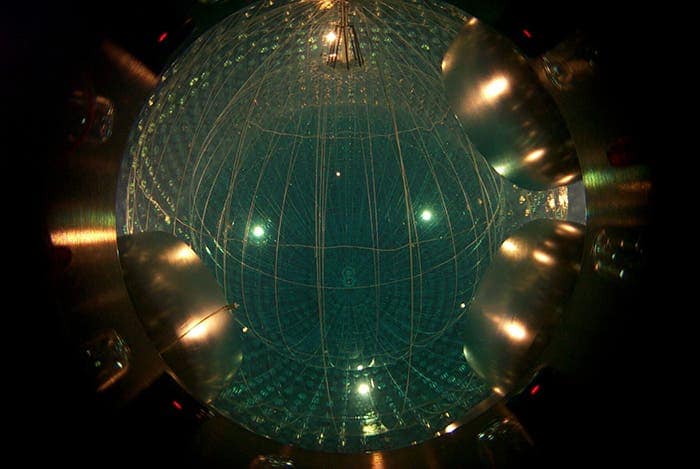You know how the old saying goes, that “diamonds are forever,” and giving your significant other a piece of diamond jewelry is considered to be a declaration of eternal love? Well, scientists working at the Borexino experiment in Italy may change the saying and send enamored young men scrambling for something that’s really eternal to profess their love — electrons.

The Borexino detector comprises 300 tonnes of an organic liquid that is viewed by 2212 photomultipliers.
Image via physicsworld
The Borexino experiment is a scientific endeavor to find if electrons decay into a photon and a neutrino, a process that would violate the conservation of electrical charge and would be the best proof of yet-undiscovered physical laws beyond those of the Standard Model. Electrons are the tiniest carriers of electrical charge currently known, and proving that they decay throws a big old rusty wrench into the workings of physics as we know it today — because of the law of energy conservation, when the electron decays it should pass on its electrical charge over to the newly formed, lower-mass particles.
And here’s the catch; we know that no particle smaller that an electron can carry an electrical charge, and this would mean that it simply “vanishes.” As all the theoretical scaffolding that science uses to make sense of nature, the Standard Model does not adequately explain all aspects of physics. But the discovery of electron decay could help physicists to develop a new and improved understanding of physics.
And the latest look into electron decay was done using the Borexino detector, an instrument designed to primarily study neutrinos. Built deep inside a mountain at the Gran Sasso National Laboratory to shield it from cosmic rays, the device houses 300 tonnes of an organic liquid that is viewed by 2212 photomultipliers.
The team focused on a hypothetical process through which an electron in the liquid decays to a neutrino and a photon with 256 keV energy that goes on to interact with the electrons producing a distinct flash of light in the liquid that the photomultipliers pick up. After recording light signals from January 2012 through to May 2013, the team subtracted the signals from a number of unrelated processes that occur in the detector and produce similar amounts of light as a 256 keV photon — such as radioactive decay of several trace isotopes, and light from the neutrino collisions that Borexino is designed to detect.
And they found a huge, mindblowing…..nothing. In the 408 days span, the Borexino didn’t detect any electron decay. Given this and the fact that the installation houses a vast number of electrons, the team could estimate a minimum average lifetime value of an electron. This, probably the best measurement yet of an electron’s lifespan clocks in at around 66,000 yottayears, or 66 thousand quadrillion years, five quntillion times the age we think the Universe has right now. It’s more than 100 times greater than the previous lower limit that the Borexino Counting Test Facility, a precursor to the current experiment, measured back in 1998.
Borexino spokesperson Gianpaolo Bellini told physicsworld.com that if we could further purify the detector to eliminate all background radiation, the minimum lifetime measurement could be boosted to greater than 1031 yr.
He points out that Borexino could also be used to search for decays into the “invisible channel” whereby an electron is converted into three neutrinos, or could even look for the “disappearance” of an electron into extra dimensions.
The search is described in Physical Review Letters.









